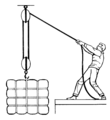1º Indicate, for each case, in which direction the balance is inclined: towards the right, left or in equilibrium.
.jpg)
2º . What mechanisms can be used if I have to raise a piano to
the 6th floor so it can enter through a window?
3º Explain the differences between a chain transmission system and a belt transmission system. Which advantages and inconveniences does each one have? Draw a picture of each.
4º Fill in the boxes of the steam machine picture.
.jpg)
5 Justify which of these machines are external combustion
versus internal combustion machines.
a. Locomotive
b. Car
c. Pressure cooker
6º The crane seen below needs to lift a pallet of cement sacks which weight 5.000N. The counterweight is 10.000N and is located at the 5m mark on the tower. At what distance of the tower will the pallet be lifted so the structure does not suffer?
.jpg)
7. If I have a force of 500N, what weight am I able to transport
with the cart drawn below?
.jpg)
8. Analyze the following mechanism systems and indicate
with an arrow the direction that they turn and the element that
turns most slowly..jpg)
9º Observe the following transmission system and answer:
.jpg)
a. What is the name of the system formed by 1 and 2?
b. What is the name of the system formed by 3 and 4?
c. If 1 turns to the right, indicate with an arrow the direction
the other elements turn.
d. If 1 turns 6 times, how many times does 2 turn?
e. If 3 turns 1.5 r.p.m and measures 10 cm, what velocity does 4
have if it's diameter is 2 cm?
f. Calculate the transmission relationship between 1 and 4.
10º In what phases are the cylinders below? Admission,
compression, explosion or escape?
.jpg)
11º Describe the differences between a car motor and a motorcycle motor.
12º Indicate the needed force in the following cases..jpg)
13 . In a transmission system formed by toothed wheels ,
the wheel , which has 20 teeth, makes 5 turns per minute and
moves B, which has 100 teeth,
a. Draw a picture of the system.
b. At what speed does B move?
c. Which toothed wheel has the most force at it's axis?
14. If I want to push a car that weighs 8,000N up a hill that is
100m long and 1m high, can I do it with a pushing force of 300N?
Solutions:
1º a) To the left ,
b) Equilibrium , c) To the right , d) To the left , e) To
the right , f) To the left
 2º
A block and tackle ( image on the left ) which is a
system of two or more pulleys with a rope or cable threaded
between them.
2º
A block and tackle ( image on the left ) which is a
system of two or more pulleys with a rope or cable threaded
between them.
3º The chain transmission system uses chain and sprockets. The belt transmission system uses pulleys and belt. Benefits: greater efforts transmitting in chain and belt absorbs braking and acceleration without breaking. Disadvantage: The chain is more expensive and louder and the belt is more fragile.
4º Boiler, Oven, valve, piston, cylinder, valve, condenser, Rod / Crankshaft.
5º External Combustion: locomotive and pressure cooker, because the fuel is burned outside. Internal Combustion: car, because the fuel is burned inside the engine.
6º Applying the law of the lever and replacing: F · BF = R · BR → 5000 N · BF = 10 000 N · 5 m → BF = 10 m
7º Applying the law of the lever and replacing: F · BF = R · BR → 500 N · 1 m = R · 0,4 m → R = 1250 N . Therefore, we can carry 1250 N.
8º a) 2 rotates more slowly. 1 and 2 rotate in opposite directions. b) 3 rotates more slowly. 1 and 3 rotate in opposite directions to 2. c) 3 rotates more slowly. 1 and 3 rotate in opposite directions to 2. d) 1 rotates more slowly. 1 and 2 rotate in the same direction. e) 5 rotates more slowly. 1, 3, 4 and 5 rotate in opposite directions to 2.
9º a) chain drive system. b) belt drive system. c) All clockwise. d) Z1 · ω1 = Z2 · ω2 → 4 · 6 rpm = 16 · ω2 → ω2= 1,5 rpm
e) Φ3 · ω3 = Φ4 · ω4 → 10 cm · 1,5 rpm = 2 cm · ω4 → ω4 = 75 rpm f) r = ω4 / ω1 = 75 rpm / 6 rpm = 12,5
10º Compression and
escape.
11º The difference is that the car engine is a four
stroke motor , and the bike a two stroke motor .
12º a) 100 N. c) 3600 N. b)
200 N. d) 1000 N.
13º b.) Applies the equilibrium equation: ZA · ωA = ZB · ωB → 20
· 5 rpm = 100 · ωB → ωB = 1 rpm . c) The B, because it rotates
more slowly.
14º In an inclined plane :
F = R · a / b. Data: R = 8000 N, a = height = 1 m,
b = distance travelled = 100 m. Therefore: F = 8000 · 1/100 = 80
N. Yes, because with a 80 N force is enough to tow the vehicle.